Ten days ago i went to the opening of Homo Ludens Ludens the at LABoral Art and Industrial Creation Centre in Gijon, Spain. Homo Ludens Ludens, the third part of a trilogy the center dedicated to games, explores play as a key element of today’ s world.
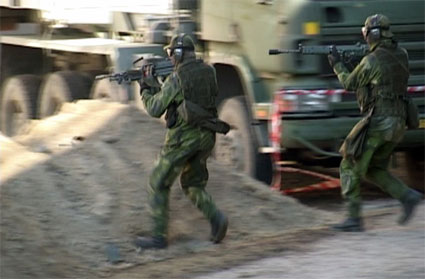
I’ll come back with more details about the exhibition in the next few days but as a smooth prelude to the lengthier coverage, here’s a few words about Art of War Parts 4b and 4c , one of the projects i particularly liked.
Art of War features two puzzling video works. Is that a war movie we are watching? A warzone documentary? A news clip? It’s also almost impossible to identify the date of the events or to locate the city where the fight takes place. It might be Beirut or Sarajevo.
The warzone was downtown Stokholm. It was a Saturday afternoon, in Spring 2006. It wasn’t much of a conflict either, it was a two day army exercise in which lasers were substituted for real bullets and blood and guts are imaginary.
John Paul Bichard (you might remember his beautifully manipulated gamespace interiors) woke up to the sound of heavy machine-gun fire in Stokholm. Armed with a video camera, he recorded the moves of an army whose tanks, troops, APCs and heavy weaponry were simulating a war and using a Saturday afternoon in the city as a battelfield. Right amidst pedestrians, and passing civilian cars and buses…
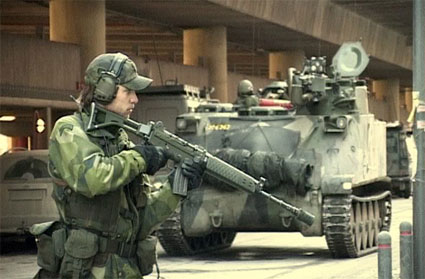
The video works explore the nature of violence and how violent conflict is contextualised in the digital media age. As ‘real’ conflict zones become more restrictive, press access more heavily orchestrated, Bichard constructs an intrusive, voyeuristic commentary on the banality of warfare, the fine line that separates authoritarian control from abuse of power and the ease with which society is incorporated into the mechanisms of institutional violence. Uninvited by the authorities and provided only with earplugs, the works document a thrilling encounter with a grim game.
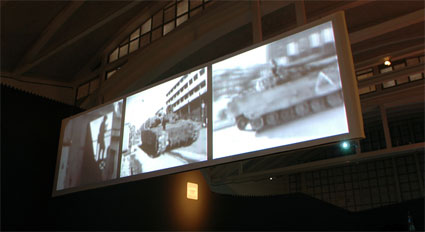 View of the installation at LABoral (image courtesy of the artist)
View of the installation at LABoral (image courtesy of the artist)
A couple of questions to John-Paul:
You woke up to the sound of heavy machine-gun fire on morning in Stokholm. It was a complete surprise for you. Still, you grabbed a camera and shot what you saw. At which point did you realize that you wanted to use the footage for an artwork? Was it immediate? Or is it the result of a longer process?
I have played video games so much over the years that my life, the games and my art are in a fluid relationship to each other – so the sound of gunfire was literally a trigger for me. I didn’t have any solid idea at the time as to what I would finally do with the footage but I had previously been doing some short mobile phone video experiments so the seed was already sown. Much of what I do I either intellectually file away or stick in a folder on one of my highly disorganized hard drives so the footage sat on the drives for some months, then one day I just started to go through it. That’s when I rediscovered Edwin‘s music which had also been sitting around for ages – the video and the musical compositions simply made sense when I started combining them.
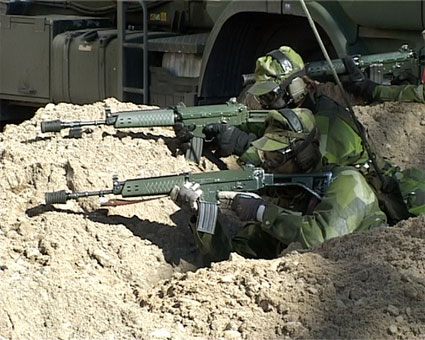 Did you feel like a reporter camera in hands or a gamer while you were in the streets with the soldiers?
Did you feel like a reporter camera in hands or a gamer while you were in the streets with the soldiers?
Well both really, I guess you could say it was like a war correspondent simulation game: a meta-game to the Swedish army’s anti-terrorist war game on the streets of Stockholm. When i got to the border of the area, i was greeted by soldiers standing at a table – i was a little nervous thinking I would have to sneak around to get some footage, but they just handed me earplugs and told me to keep away from the tanks (which i didn’t and nearly got run over :)). I felt very much like a war cameraman, running from one melee to another. At one point i was shouted at for popping up in the middle of a fire fight – it’s hard to explain the feeling of adrenaline when you have a gun pointed at you or you hear a heavy gunfire down the end of a road even if it is just blanks. I still think it’s amazing that the exercise was so open to the public, but that is not uncommon for Sweden. I can’t imagine the same thing happening in London or Washington DC.
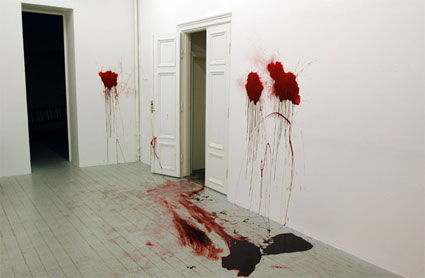 Inverse Forensics, part of the Evidencia series
Inverse Forensics, part of the Evidencia series
The work is part of your Violencia series, what is its place in the series? How does it differs and / or what are its common points with the other Violencia art pieces?
Well so far there are two works in the series: [art of game] Art of War Parts 1 to 3 which was shot using a high quality 3 chip DVCAM and [art of game] Art of War Parts 4b + 4c which is a double trilogy made from mobile video clips. These works are only the start of the series which follows on from and expands upon the evidencia series. Whilst the evidencia works looks more directly at the metaphors and tropes of videogames, exploring the aesthetics, ethics and power relationships common in violent games,. the violencia series focuses on exploring our need to consume fictionalised violence and our relationship to institutionalised violence. Whilst Parts 1 to 3 has a more documentary feel to it, the work shown at Laboral is more subtle. Mobile video has a very painterly quality to it and by screening the same trilogy on each side of a panel with one work reversed and in colour, the other in black and white, the scenes become very ambiguous. The footage could have come from Warsaw in 1940, the middle east in the 70s, Bosnia in the 90s, it becomes very hard to place and I like that slippage. Whilst both works are fragmentary narratives, playing with documentary, media and cinematographic tropes, ‘Parts 4b + 4c’ are perhaps a more poignant reminder that whilst a 40million kronor war game was going on in my neighbourhood, not so far away in the world people were waking up to real gunfire on that Saturday morning.
Thanks John-Paul!
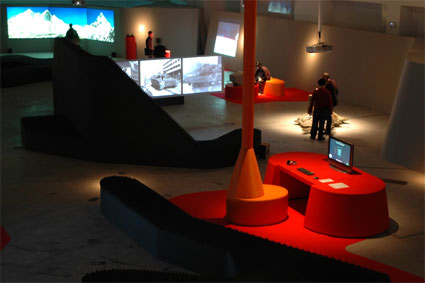 View of the installation at LABoral (image courtesy of the artist)
View of the installation at LABoral (image courtesy of the artist)
Homo Ludens Ludens runs until 22nd September 2008. If you manage to get to Gijon before May 12, you’ll also be able to see the Emergentes exhibition dedicated to media art projects developed by Latin American artists (previous reviews: Life inside bubbles, Emergentes – 10 projects by Latin American artists (part 1), and Part 2.)
Art of War parts 1-3 is part of the Try again exhibition, at La Casa Encendida, in Madrid. On view until June 8, 2008.
Also by John-Paul Bichard: Back Seat Gaming.
